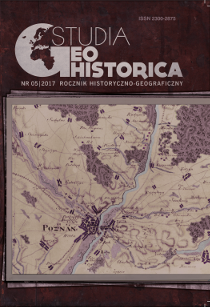Granica mazowiecko-litewska między Wizną a Grodnem z 1358 r.
The Mazovian-Lithuanian Border between Wizna and Grodno from 1358
Author(s): Henryk RutkowskiSubject(s): Historical Geography, 13th to 14th Centuries
Published by: Polskie Towarzystwo Historyczne
Keywords: border;borderland;Mazovia;Lithuania;Podlasie voivodeship;retrogressive method;granica;pogranicze;Mazowsze;Litwa;województwo podlaskie;metoda retrogresji
Summary/Abstract: The document which makes the basis of the present article was issued in Grodno on August 14, 1358. The issuer was Kestutis, a Lithuanian duke, while the receiver was duke Siemovit III, who – as the Polish king Casimir the Great’s liege – ruled as the only duke in Mazovia. The document states that Kestutis made an agreement with Siemovit by virtue of which the border between the lands of Lithuania and Mazovia was established on the basis of what the representatives of both parties determined. In a 2000 edition of the document the publishers found the document forged. The examination of the original performed by experts in paleography showed that the document is authentic. The Kingdom of Poland concluded some kind of an agreement with the Grand Duchy of Lithuania in 1356, the result of which was a longer period of peace between those countries. This helped regulate the controversial matters on the border between Mazovia (Wizna area and Goniądz district) and Lithuania (Grodno territory). That frontier territory was covered with woods, where permanent settlements were situated only on the outskirts, close to the rivers Narew and Biebrza from the side of Mazovia, and close to the river Niemen from the side of Lithuania. A lack of settlement was due to frequent invasions in the 14th century by Lithuanians and the Teutonic Knights, which order had their own state in Prussia. The Polish population, Mazovians, entered the woods from the west, while the Ruthenians approached from the east but before the border was established, the frontier was no man’s land in the political sense. The author of the present article does not agree with the thesis which predominated in the literature of the subject that until 1358 the Mazovian border with Lithuania had run about 12–15 km away from Grodno. Those were only the territorial claims of Mazovian dukes. The document emphasizes that both Lithuania and Mazovia recognized a need to determine the border and its course was established by their representatives (mediators), five from each side. The first map presents the whole border described in the document from 1358, while the second one shows the details of the final part of the border on the basis of the source from 1784. It is only the initial part between the rivers Ełk and Netta which did not come into life (in 1360 the Teutonic Knights occupied Rajgrod). The whole further section of the border proved to be the most lasting in that area. Since the end of the 14th century it was the inner border in Lithuania and when in 1569 the Sejm of the Lublin union joined Podlasie voivodeship to the Crown the 1358 border became established as a part of the Polish-Lithuanian border. It remained without any changes till the collapse of the Republic in 1795. This justifies the decision to use the method of retrogression to reconstruct the border. The section of the border seen in the second map was presented in the literature of the subject in a completely different way and this is the reason to show this map.
Journal: Studia Geohistorica
- Issue Year: 2017
- Issue No: 5
- Page Range: 140-155
- Page Count: 16
- Language: Polish

